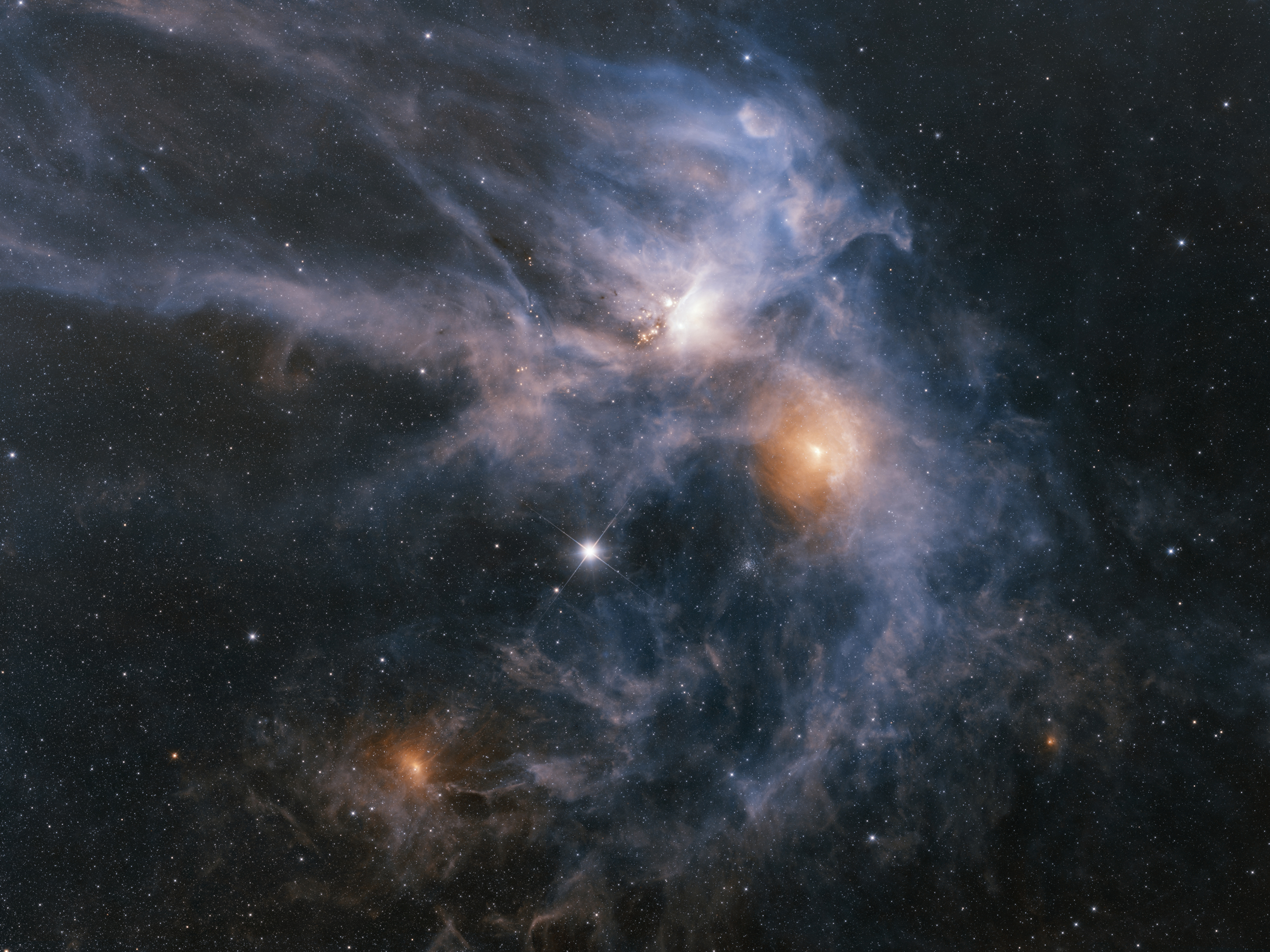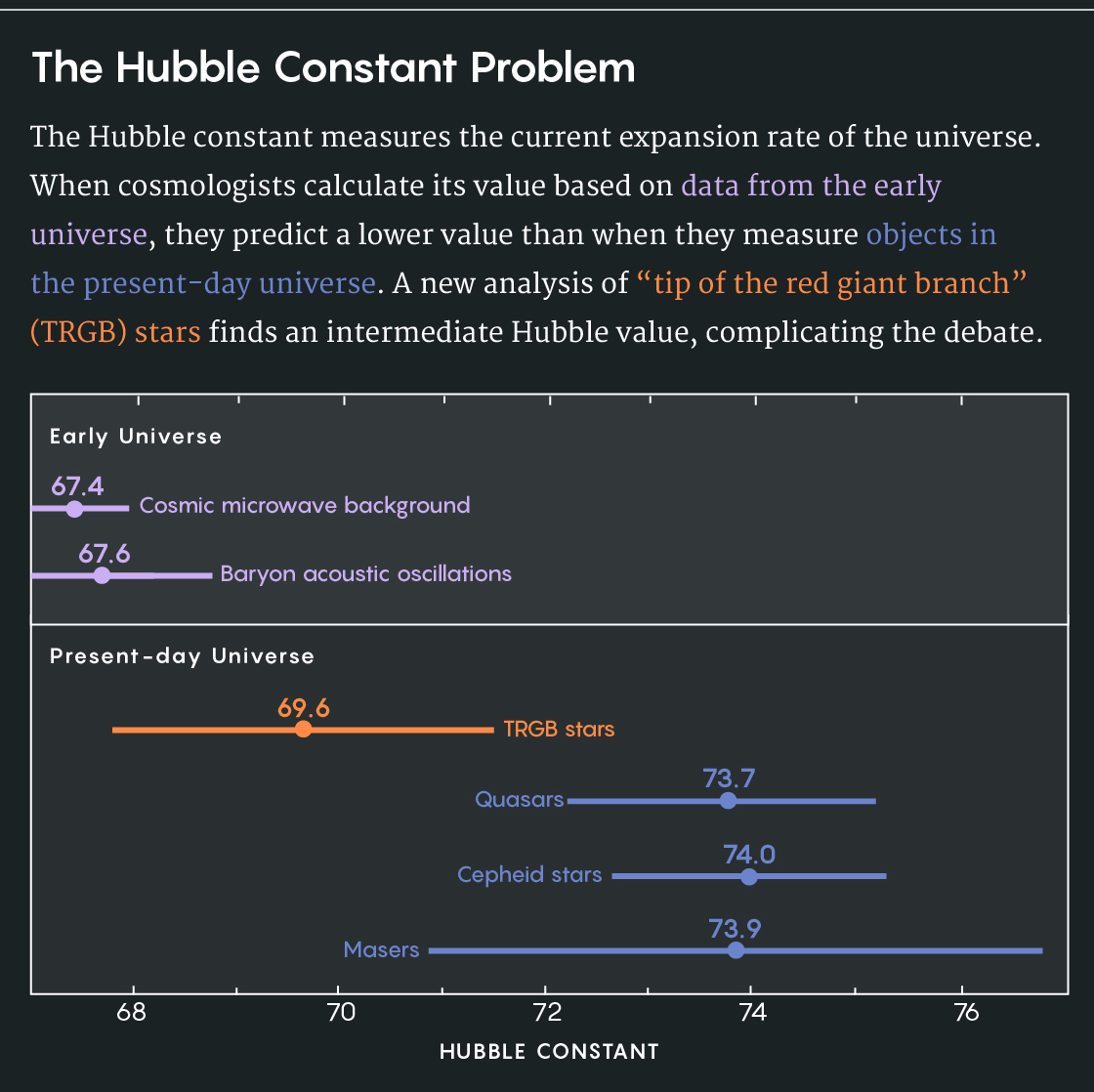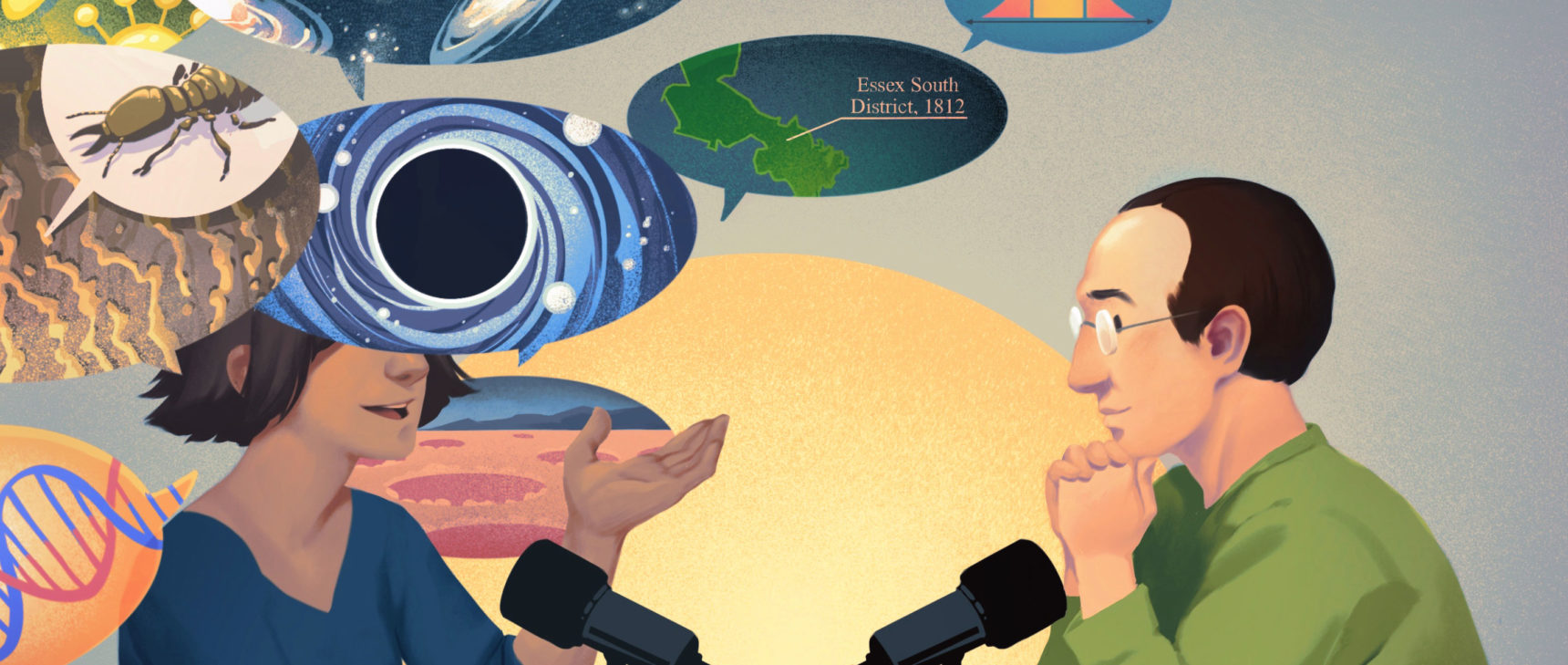New Wrinkle Added to Cosmology’s Hubble Crisis

Antares, seen at center, is a red supergiant star near the end of its life. Similar red-giant stars have complicated the debate over the Hubble constant.
Introduction
The big news in cosmology for several years has been the mounting evidence that the universe is expanding faster than expected. When cosmologists extrapolate data from the early universe to predict what the cosmos should be like now, they predict a relatively slow cosmic expansion rate. When they directly measure the speed at which astronomical objects are hurtling away from us, they find that space is expanding about 9% faster than the prediction. The discrepancy may mean that something big is missing from our understanding of the cosmos.
The issue reached a crescendo over the past year. Last March, the main group measuring cosmic expansion released their updated analysis, once again arriving at an expansion rate that far outstrips expectations. Then in July, a new measurement of cosmic expansion using objects called quasars, when combined with the other measurement, pushed past “five sigma,” a statistical level that physicists usually treat as their standard of proof of an unaccounted-for physical effect. In this case, cosmologists say there might be some extra cosmic ingredient, beyond dark matter, dark energy and everything else they already include in their equations, that speeds the universe up.
But that’s if the measurements are correct. A new line of evidence, first announced last summer, suggests that the cosmic expansion rate may fall much closer to the rate predicted by early-universe measurements and the standard theory of cosmology.
Wendy Freedman, a decorated cosmologist at the University of Chicago and Carnegie Observatories, measured the expansion rate, known as the Hubble constant, using stars that she considers cleaner probes of expansion than other objects. Using these “tip of the red giant branch” (TRGB) stars, she and her team arrived at a significantly lower Hubble rate than other observers.
Although Freedman is known for her careful and innovative work, some researchers pushed back on her methods after she introduced the result last summer. They argued that her team used outdated data for part of their analysis and an unfamiliar calibration technique. The critics thought that if Freedman’s team used newer data, their Hubble value would increase and come in line with other astronomical probes.
It did not. In a paper posted online on February 5 and accepted for publication in The Astrophysical Journal, Freedman’s team described their analysis of TRGB stars in detail, summarized their consistency checks, and responded to critiques. The new paper reports an even slower cosmic expansion rate than last summer’s result, a tad closer to the early-universe rate. The more up-to-date data that critics thought would increase Freedman’s Hubble value had the opposite effect. “It made it go down,” she said.
The Trouble With Dust
The question of whether the universe expands faster than expected first cropped up in 2013, when the Planck satellite precisely mapped ancient microwaves coming from all directions in the sky. The microwaves revealed a detailed snapshot of the early universe from which the Planck team could deduce the cosmos’s precise ingredients, like the amount of dark matter. Plugging those ingredients into Albert Einstein’s gravity equations allowed the scientists to calculate the expected expansion rate of space today, which Planck’s final, full analysis pegged at 67.4 kilometers per second per megaparsec, give or take 1%. That is, when we peer into space, we should see astronomical objects receding from us 67.4 kilometers per second faster with each megaparsec of distance, just as dots on an inflating balloon separate faster the farther apart they are.
But Adam Riess, a cosmologist at Johns Hopkins University and the Nobel Prize–winning co-discoverer of dark energy, had for a few years been getting a higher value in direct measurements of the cosmic expansion rate. The trend continued; as of their latest analysis last March, Riess’s team pegged the Hubble constant at 74 kilometers per second per megaparsec, 9% higher than the 67.4 extrapolated from the early universe.

The catch is that directly measuring the Hubble constant is very tricky. To do so, astronomers like Riess and Freedman must first find and calibrate “standard candles”: astronomical objects that have a well-known distance and intrinsic brightness. With these values in hand, they can infer the distances to standard candles that are fainter and farther away. They then compare these distances with how fast the objects are moving, revealing the Hubble constant.
Riess and his team use pulsating stars called cepheids as their standard candles. The stars’ distances can be measured with parallax and other methods, and they pulsate with a frequency that correlates with how intrinsically bright they are. This lets the astronomers gauge the relative distances to fainter cepheids in farther-away galaxies, which gives them the distances of “Type 1a supernovas” in those same galaxies — explosions that serve as brighter, though rarer, standard candles. These are used to measure the distances to hundreds of farther-away supernovas, whose recessional speed divided by their distance gives the Hubble constant.
Riess’s team’s Hubble value of 74 became more convincing last year when an independent measurement using quasars yielded the similar result of 73.3, a measurement based on objects called masers landed at 73.9, and an additional independent quasar measurement returned 74.2.
But Freedman, who helped pioneer the cepheid method now used by Riess, has long worried about possible sources of error. Cepheids change as they age, which is not ideal for standard candles. Cepheids also tend to exist in dense stellar regions, which has two nefarious effects: First, those regions are often filled with dust, which blocks starlight and makes objects look farther than they are. And second, crowding can make them look brighter and thus closer than they are, potentially leading to overestimation of the Hubble constant. That’s why Freedman set out to use tip of the red giant branch stars.
TRGBs are what stars like our sun briefly become before they die. As red giants, they gradually grow brighter until they reach a characteristic peak brightness caused by the sudden ignition of helium in their cores. These peaking red giants are always the same, which makes them good standard candles; moreover, as old stars, they inhabit the clean, sparse outskirts of galaxies, rather than dusty, crowded regions. “In terms of simplicity, tip of the red giant branch wins hands down,” said Barry Madore, Freedman’s husband and main collaborator, also of Chicago and Carnegie Observatories.
First, Freedman, Madore and their team had to calibrate the TRGB stars, figuring out how bright they are at some known distance. Only then could they compare the brightness (and thereby deduce the distance) of TRGBs and supernovas farther away.
For their standard candles, they chose the population of TRGB stars in the Large Magellanic Cloud, a nearby galaxy whose distance is extremely well known. The Large Magellanic Cloud is dusty, so the stars’ brightness can’t be directly observed. Instead, Freedman and her collaborators measured the intrinsic brightness of TRGBs in two other, essentially dust-free (but not as precisely located) places: a galaxy called IC 1613, and the Small Magellanic Cloud.
TRGBs in these pristine places are like the sun when it’s high in the sky, whereas TRGBs in the Large Magellanic Cloud are like the sun near the horizon — reddened and dimmed by the dust in the atmosphere. (Dust makes objects look redder because it preferentially scatters blue light.) By comparing the colors of stars in dusty and clean places, the researchers could infer how much dust there is in the dusty region. They found that there’s more dust in the Large Magellanic Cloud than previously thought. That revealed how much the dust dims the stars there, and thus how bright they truly are — allowing the stars to be used as standard candles.
The team independently checked the relative distances of the Large and Small Magellanic Clouds and galaxy IC 1613 using other methods, and they performed a number of other consistency checks on their result. Their TRGB distance ladder yields a Hubble value of 69.6, well below the measurements using cepheids, quasars and masers and within shouting distance of the prediction from the early-universe data.
“We run all of these tests, keep on getting the same answer,” Madore said. “And Adam [Riess] doesn’t like it.”
The Mystery Endures
Riess said that although he “appreciates being able to read more about” the team’s methods, he still thinks their TRGB calibration could be off. “Estimating the amount of dust that dims the tip of the red giant branch in the Large Magellanic Cloud is very difficult,” he said. One possible source of error, he said, is that the Small Magellanic Cloud has an extended shape, with TRGBs located at different distances that shouldn’t necessarily be averaged together. (Freedman says her team measured TRGBs only in the central portion of the cloud.)
Riess emphasizes that the TRGB result must be weighed against several other independent measurements that get a higher Hubble value.
Dan Scolnic, an astrophysicist at Duke University who collaborates with Riess on the cepheid measurements, also questioned Freedman’s calibration method, saying, “Getting to the bottom of this is going to be one of the most important things the [community] does in the next couple of years.”
The controversy will get resolved as telescopes gather more data, including highly accurate direct measurements of distances to TRGB stars. Over the next few years the Gaia satellite should provide these observations.
Other clues may come even sooner. Freedman said her team has used yet another new method to make a not-yet-published Hubble measurement that agrees with their number from the TRGB stars. Although she wouldn’t go into details about the forthcoming result, she said, “At the moment we think the case is exceedingly strong” that the TRGB measurement is correct.
Update: February 26, 2020
When this article was first published, two paragraphs were in the wrong place. The text has been corrected.
This article was reprinted on Wired.com.



